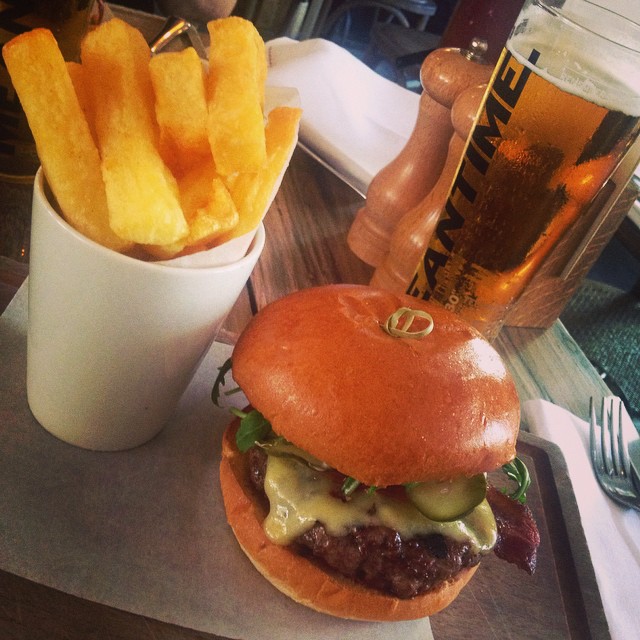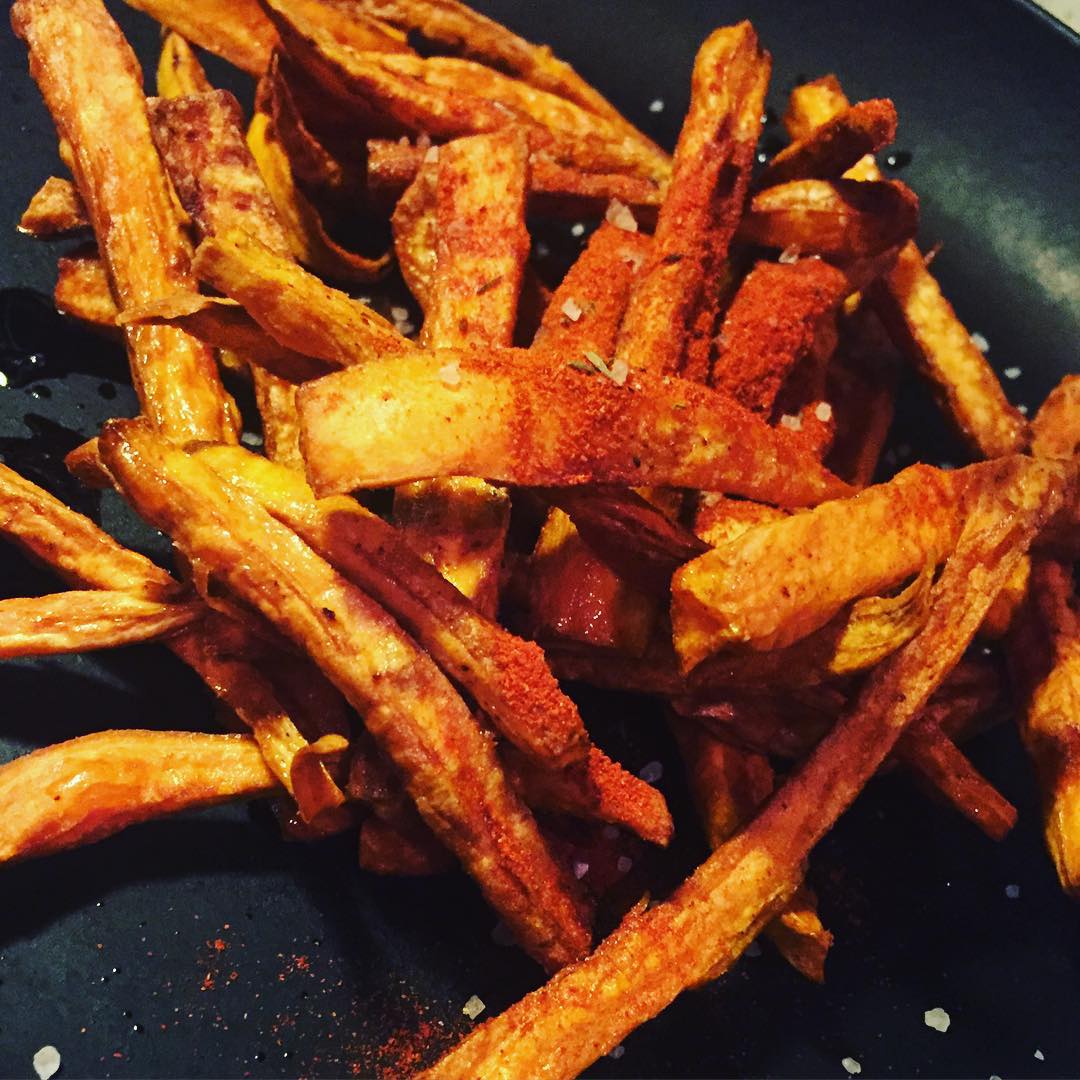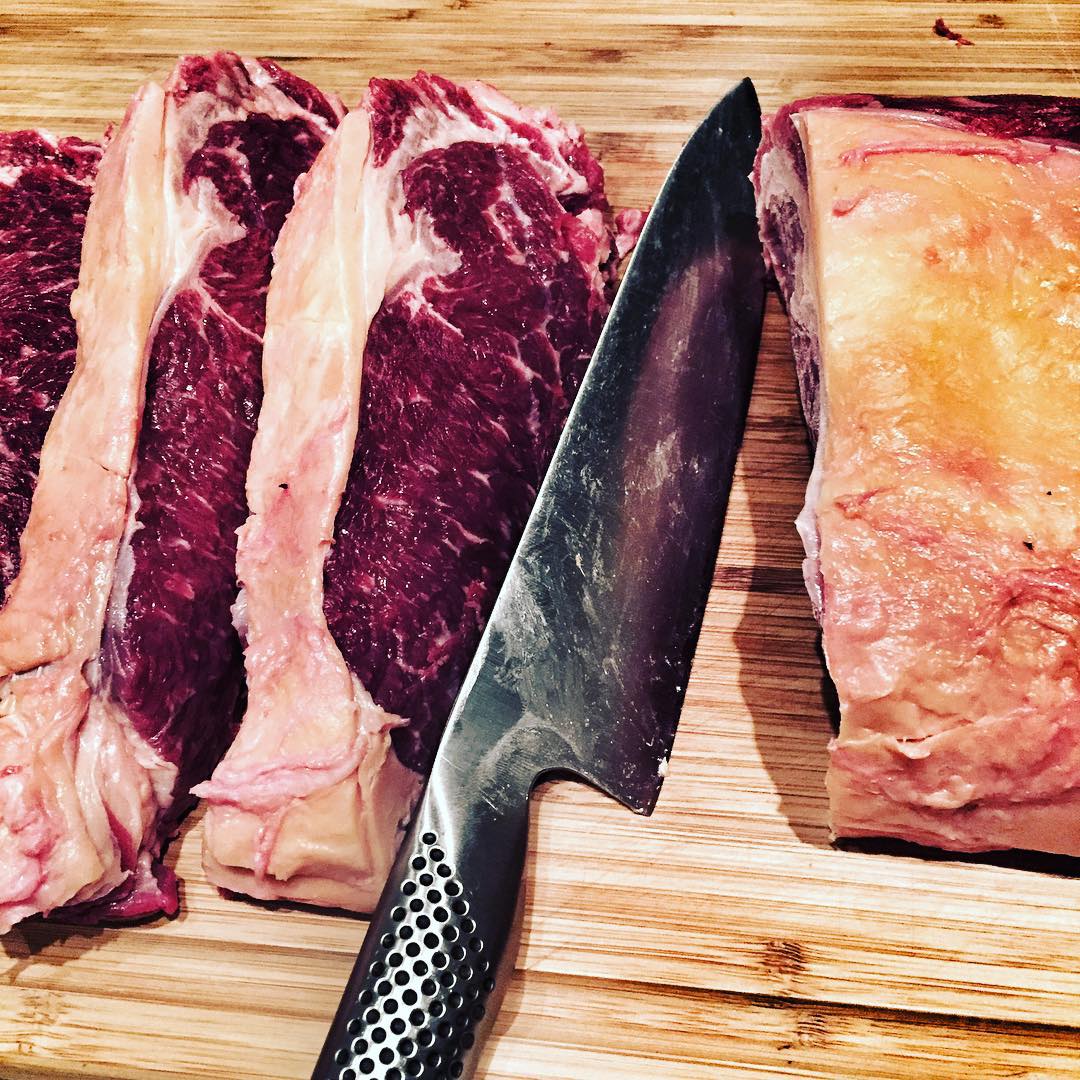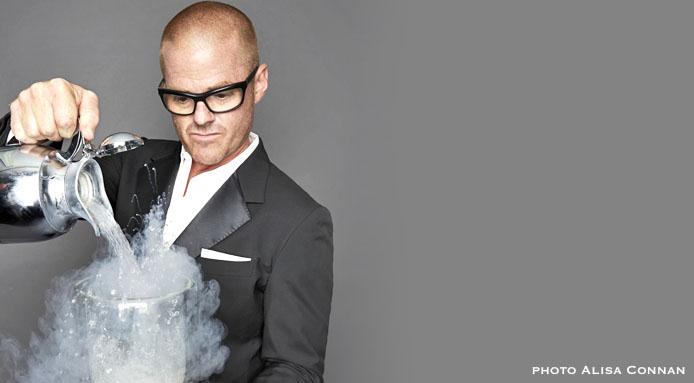Triple-cooked chips is the perfect obsession I thought I’d never have. Wait, allow me to explain…
Ever wanted to make perfect French fries? I know I didn’t! Until very recently, I didn’t even really care for French fries. They always seemed either too soggy, too undercooked, too overcooked, too oily, too burnt or any combination of the above. Then a trip to the Southern US turned my perspective on fried food completely upside down. I realized that fried food, when done right, can be non-oily, perfectly crispy, golden brown and delicious bites of heaven.

Triple-cooked chips: Yes, French fries can be perfect!
And, within the course of about five seconds, I went from not digging on fried foods at all to knowing I somehow had to recreate the spectacle of the perfect deep fry at home.Heston Blumenthal and the quest for the perfect French Fries
In the true spirit of trial and error, it took me about a year to do. With some results, admittedly, more successful than others – in a putting it mildly kind of way. But finally, a couple of weeks or so ago, I succeeded. I succeeded more than I could have ever hoped. I succeed to a point where people actually told me “this is beyond French fries, its something else… Something else that puts other French fries to shame!” (no, honestly!).
And as humbling as that was, I wish I could take full credit, I really do. But really, honestly, the procedure wasn’t really mine, it was nicked (as the Brits, would say) off a guy far geekier than myself; a certain Brit by the name of Heston Blumenthal. Now, if you don’t know who Heston Blumenthal is, well, he’s an annoying human being is what he is… An autodidact chef who rose to three Michelin-starred fame as the proprietor and executive chef of The Fat Duck Restaurant, became a defining figure within the field of molecular gastronomy, a notable cookbook author, television personality and an all-out source of inspiration for food geeks around the world… All of this owing largely to his charismatic personality and the fact that he stops at nothing to make his dishes a veritable assault on the senses, both visually and tastewise.
In short, it’s hard not to be impressed by the culinary track record and work of Mr. Blumenthal… Or maybe that’s just me, maybe I just somehow relate to overly geeky balding men with glasses, I don’t know. Whichever the reason, I’ve taken a liking to Mr. Blumenthal and his relentless and sincere devotion to detail and added steps in the name of great flavor. Actually, he’s become a culinary hero of mine. Heston, much like this humble blogger, spares absolutely no expense or no time in creating the best dishes he possibly can, only his creations make mine look like absolutely simple little creations. Seriously.
From his perfect Spaghetti Bolognese (which I’ve sort of mirrored here) over his delightfully complicated burgers with homemade condiments and brioche-style buns to his chicken tikka masala cooked in a custom-built tandoor oven, his creations much more than mine beg the question: is this really worth all the hard work? And, well, aside from the obvious wow factor, the answer – to the home chef – may in some cases be a resounding “meh?” … Yet in others, as is the case of his triple-cooked chips (Chips British for French fries, by the way), a thundering “Hell F’ing Yeah!”

Triple-cooked chips have become a mainstay in restaurants and gastro pubs across the world… With very good reason, I do reckon.
These fries, the subject of this post, are world famous for a reason, and unlike many of his other efforts… they’re done in four hours or less!
Four hours?! For French Fries?!?
See, I had a feeling this was going to happen… Again, I know four hours sound like a lot for a batch of French fries and, indeed, it probably is. But it’s all for very good reasons and don’t you worry, only about a half hour or so is active cooking time. The rest of it you can put to good use doing something else like enjoying a nice glass of red wine or getting something else done around the kitchen… Like, I don’t know, plotting and preparing the perfect steak to go along!
“But really,” the naysayers amongst you may still be saying. “Four hours sound like a lot of time to wait. And 30 minutes of active cooking when I can just dump some frozen fries in a fryer and have almost instant gratification? Honestly, Johan, how, when and why would I go about doing this?” Well, as every young achiever’s favorite person, Simon Sinek, would say: “let’s start with the why!” The reason as to why you would do this is, quite simply, because they’re unlike any French fry you’ve ever had before, they’re an epiphany within the fried stuff layer of the food pyramid. They are, quite simply… perfect!
The anatomy of a perfect French Fry
What is a perfect French fry, you might ask? Well, basically, it’s everything that a bad, mediocre or even near-perfect French fry isn’t:
- A soft, velvety interior completely devoid of oil and sogginess
- A firm, thick, crispy exterior with an out of this world crunch
- A golden brown and delicious crust flavored by the heat of the oil, not the oil itself
- A soft mouthfeel interior encased in a solid crunchy exterior that comes from going right from oil to plate
… And it’s every single one of those things at once, coupled with a blast of extra flavor from a last-minute sprinkling of quality sea salt. As simple as this combination sounds, most aficionados will know that it is rarely ever achieved. Rarely ever do we see the perfect combination of soft interior, crunchy exterior, crispiness, browning and taste. Almost always do the near-perfect French fry fall short in one of said categories… Which probably goes to explain why a resilient guy such as Heston has spent God knows how long devising a four-hour method to slowly but steadily achieve perfect results – every single time!

See, they’re good fries. I have to say that, I made them. But they’re not Perfect French Fries!
And, yes, it does sound like a lot of work for the home chef, but as I’ve tried to tell people by way of this blog for the past couple of years, some things are worth fighting for! Trust me. If you only ever try one of these seemingly overly complicated recipes that I share, let this be the one. Trust me, the results will change your life.
No special equipment needed! You don’t need any special equipment to make perfect French fries. A standard cast iron dutch oven and a thermometer will do just fine. If you have an electric deepfrier, by all means, use it. It will only make things easier on you. If not, fear not, these instructions will work just as well without one.
Alright, I’ve managed to convince you? Awesome! Having covered the why, let’s now move on to the how part of the equation!
How to make perfect French Fries … Every time!
Now, these are obviously called Triple-cooked chips for a reason. Yep, you guessed it, we’re frying them three times, but before we even get to that part, we’ve got some work to do. For starters we’re going to pick the right potato! Yeah, that’s right, a perfect French fry does not come from any old potato.
First of all, the perfect French fry potato must be large enough to cut into relatively large fries. And by relatively large, I mean something in the 1cm x 1cm range. If the fries are too small, the interior will have overcooked by the time the exterior has had a chance to crisp up.

I’m not saying it’s not complicated… I’m saying it’s worth the trouble!
Secondly, no two types of potatoes are alike and variety does matter. If you’re lucky enough to shop at a place where potatoes have names, look for either of the following: Maris Piper, Russet (Burbank) or Bintje. Otherwise, try finding something that’s not too starchy but rather fluffy or floury. Basically, the kind of potato that crumbles and falls apart when overcooked rather than turning to mush.
Once you’ve sourced a good potato for the purpose, comes the hard part, the proper (triple) cooking of our potato of choice. The entire process is detailed in the recipe below, but basically it goes a little something like this:
- Cut potatoes, then wash them properly to remove excess starch.
- Simmer gently for 20-30 minutes to create fluffy interior and a rugged surface for the oil to cling onto during cooking.
- Freeze for an hour to remove excess moisture.
- Fry gently in oil for about seven minutes to start the crisping process.
- Freeze for another hour to, once again, remove excess moisture.
- Fry in blazing hot oil for another five-seven minutes or until golden brown, delicious and crunchy on the outside yet beautifully fluffy on the inside.
And, uhh, a lot of that probably makes sense to you… While some of it may not! Parboiling the potatoes obviously helps create the soft, floury interior that we’re after while breaking up the surface as well, creating little nooks and crannies that the oil can cling to and crisp up. So far, so good. As for the freezer part? I’m sure that has some of you a little confused.
Basically, a soggy French fry will *never* crisp up so between cooking cycles, we’ll want to remove as much excess moisture as possible. Mr. Blumenthal apparently went through a lot of experiments here, trying everything from a hair dryer to a vacuum pump to dry out his potatoes. In the end, the best tool for the job turned out to be the freezer. So stick them in there for an hour between cooking cycles – it truly works. If your guests ask, you can always tell them either “Because… Science!” or “Because… Magic!” – the choice is yours, but I’m partial to the latter.
As for the double frying in oil? Elementary, my dear reader, these fries need time to finish and to crisp up properly. If we just fry the full blast for a good ten minutes, they’ll burn before reaching the correct, desirable level of doneness and crispness… And burnt food is never good eats! If, on the other hand, we par-fry them, repeat the moisture removal process and then fry them again, things turn out beautifully every time! That, by the way, is science – not magic!
Want to test it out for yourself? Go on, then, I dare you… I triple-cooking dare you!
Triple-cooked chips: The perfect French Fry recipe!
IMPORTANT SAFETY NOTE! Now, I don’t mean to suggest that frying is dangerous, but hot oil, and burning oil, should be treated with a lot of respect! First of all, bear in mind that foods submerged into oil will not only displace oil according to their volume, they will also create a fair amount of bubbling. If using a deepfrier, do NOT add oil above the max fill mark (or below the min fill for that matter). If using a Dutch oven or similar, only fill it about 1/3 full of oil. And keep a close eye on things during cooking obviously. Also, keep a tight-fitting lid at hand, just in case the unthinkable should happen. NEVER UNDER ANY F’ING CIRCUMSTANCES TRY TO PUT OUT AN OIL FIRE WITH WATER! IT WILL CAUSE AN EXPLOSION! If things go horribly wrong, cover the pot, turn off the heat and back the fuck away!

Triple-cooked Chips: Perfect French Fries
Ingredients
- 1 kilo of relatively large floury potatoes Maris Piper, Russet Burbank or Bintje work well
- High smoke point oil for frying
- Quality flaky sea salt for sprinkling
Instructions
Prepare potatoes:
-
Peel potatoes if you so desire or simply give them a thorough wash and scrubbing.
-
Cut potatoes into relatively thick strips lengthwise, about one centimeter by one centimeter.
-
Place cut potatoes in a large pot, cover with water and agitate them a bit - water should turn cloudy with starch.
-
Drain water and repeat the procedure a couple of times until the water runs clear.
First cooking:
-
Place pot with potatoes covered in (unsalted!) water on the stove and bring to a simmer.
-
Simmer potatoes for about 20-30 minutes or until they’re completely tender and the surface is starting to crumble and break apart.
-
Carefully drain the potatoes and place on a rack to cool slightly and release some steam.
-
Once no longer steaming, place rack with potatoes in the freezer for an hour to dry out even further.
Second cooking:
-
Remove potatoes from their resting place in the freezer.
-
Put a large Dutch oven over high heat and pour in about 10 cm worth of oil or until the oil is no more than about 1/3 up the sides of the pan. Remember, the potatoes will displace a lot of oil once they go in, and they will bubble violently.
-
Dip a thermometer into the oil and wait for it to register about 150 degrees.
-
Carefully submerge the potatoes into the oil, the cold potatoes will dramatically reduce the temperature of the oil.
-
Cook for about seven minutes at around 130 degrees until lightly browned and slightly hardened. Remove potatoes from the oil using a slotted spoon and put back on the rack to cool and release steam again.
-
Once no longer steaming, put potatoes back in the freezer for another hour until thoroughly dry.
-
At this stage, the potatoes can be kept in the fridge for up to three days, or they can move on for the final frying.
Third cooking:
-
Remove potatoes from the freezer (or fridge if made ahead).
-
Reheat the oil-filled Dutch oven over high heat, this time to a blazing 190 degrees.
-
Very carefully add the potatoes back into the very hot oil and let them sizzle away for a good 5-7 minutes or until golden brown, crusty and delicious. Your target oil temperature for this frying is 180 degrees.
-
Once absolutely golden brown and delicious, carefully remove potatoes from the oil, place on a tray or similar and sprinkle with quality salt, then toss briefly and serve immediately for the best French fry experience of your life.
Recipe Notes
Neutrally-tasting, high smoke-point oils like sunflower and peanut oil are great for deep frying. Rapeseed oil, too, but it's a little less flavor neutral.
And there you go. Follow this relatively simple albeit lengthy procedure carefully and to the letter and you, too, will see that fried foods can be little golden nuggets of culinary awesomeness and much more than a soggy side order. Indeed, if done correctly, they can be the star of a meal. I kid you not!

Prime Rib! A perfectly reasonable side dish for perfect french fries!
Oh… Think I forgot the when? Of course not! We covered the how and the why, the question that remains, then, is: When do you serve these babies? The answer is easy: on special occasions. The fact aside that fried foods shouldn’t be every day foods, this is obviously a special occasion sort of meal. One that takes effort. One you save for boy’s night, date night or even… New Year’s Eve!
Trust me, your guests would be well pleased with a bit of perfectly roasted prime rib, triple-cooked fries and Bearnaise Sauce for dinner on the last day of the year… I’ve done the research so you don’t have to!

Ja, naturligvis brioche-boller! Ikke flere trælse, enten oversprøde-tørre eller megakardemomme-gærdejs-klæbrigheder. Fed blog du har Johan, tak for god læsning J
Smør er vejen frem! Christina, du er en kvinde lige efter mit hoved 😉 Det er mig, der takker – ydmygt – glad for at du nyder læsningen! 🙂
If you boil the potatoes for 20-30 minutes they will be dissolved. 5-8 minutes maximum I’d say.
They shouldn’t boil, they should be barely simmering. Cooking time obviously depends on the potato, but I just cooked a batch for 20+ minutes without any issues what-so-ever. They should be sort of brittle to the touch, but obviously not dissolved.
Can I leave the potatoes to freeze the second time for more than an hour, instead for a whole day?
Hi Kiara,
Good question! I’ve honestly never tried. I wouldn’t see any immediate problem in doing so, but you would have to experiment with cooking time and temperature for the final fry if preparing from a frozen state. Would be well worth a shot 🙂